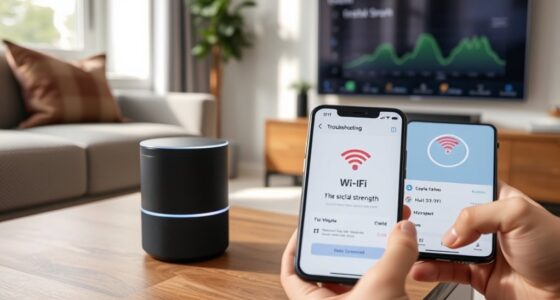The future of living with smart home trends promises greater energy efficiency, enhanced security, and seamless integration. Expect your home to automatically adjust temperatures, lighting, and security based on your routines. Devices will communicate more and learn your preferences for personalized comfort. As these systems evolve, you’ll experience a smarter, more intuitive way of life. Stay tuned, because exploring these innovations reveals how your home will adapt to meet your needs effortlessly.
Key Takeaways
- Increasing integration of AI-powered automation for personalized, adaptive home experiences.
- Enhanced energy efficiency through smarter climate control and sustainable device management.
- Advanced security systems offering real-time monitoring, remote access, and seamless integration with other smart devices.
- Greater emphasis on user-friendly interfaces, voice control, and seamless ecosystem connectivity.
- Homes becoming more responsive and intuitive, adapting automatically to residents’ routines and preferences.

Smart home technology is rapidly transforming the way you live, making everyday routines more convenient, efficient, and secure. As these innovations advance, you’ll notice how seamlessly your home adapts to your lifestyle, offering smarter solutions to common challenges. One of the biggest trends shaping the future of smart homes is a focus on energy efficiency. Smart thermostats, for example, learn your schedule and adjust heating or cooling accordingly, helping you save money on energy bills while reducing your carbon footprint. Motion sensors and smart lighting systems also ensure lights are only on when needed, further conserving energy and lowering costs. These devices not only promote sustainability but also give you more control over your energy use, making your home more environmentally friendly without sacrificing comfort.
Alongside energy efficiency, security enhancements are becoming a core feature of modern smart homes. With connected security cameras, doorbells, and locks, you gain real-time visibility and control over your property from anywhere. You can receive instant alerts if someone approaches your door or if a window is opened unexpectedly, giving you peace of mind whether you’re at home or away. Smart locks let you grant access remotely, so you don’t have to worry about hiding keys or managing copies. These security enhancements are designed to be intuitive and customizable, allowing you to tailor your home’s safety features to your specific needs. Voice-activated systems and mobile apps make it easy to monitor and manage security without complicated setups, ensuring you’re always aware of what’s happening at home.
As these technologies evolve, they will increasingly integrate to create a cohesive smart home ecosystem. Imagine your security system communicating directly with your lighting and climate controls, adjusting settings automatically based on your presence or preferences. This integration not only enhances security but also boosts energy efficiency by optimizing device operation. You’ll find that these smart solutions are becoming more user-friendly, with AI-powered algorithms that learn your habits to provide personalized automation. The integrated smart home ecosystem is a key aspect of future living, enabling a seamless and intuitive user experience. The future of living involves homes that are not only more energy-efficient and secure but also more responsive to your needs. With these trends, you’ll enjoy a home that’s safer, more sustainable, and effortlessly aligned with your lifestyle, providing comfort and peace of mind for years to come.
Frequently Asked Questions
How Secure Are Smart Home Devices Against Hacking Threats?
Smart home devices can be vulnerable to hacking threats, especially if you don’t take proper security measures. Privacy concerns and unauthorized access are real risks if passwords are weak or firmware isn’t updated regularly. To protect yourself, use strong, unique passwords, enable two-factor authentication, and keep your devices updated. Staying vigilant helps minimize these risks, ensuring your smart home remains secure against potential hackers.
What Are the Energy Savings Associated With Smart Home Automation?
Smart home automation boosts your energy efficiency by optimizing lighting, heating, and cooling systems. You’ll notice significant cost reduction as devices learn your routines and adjust settings accordingly, reducing unnecessary energy use. With smart thermostats and automated lighting, you save money on utility bills while reducing your carbon footprint. Plus, real-time monitoring helps you identify energy waste, making your home more sustainable and cost-effective over time.
Can Smart Homes Seamlessly Integrate With Existing Household Systems?
Think of your smart home as a well-orchestrated band, where every device plays in harmony. You’ll find that home interoperability and device compatibility are key to seamless integration. Modern systems are designed to work together, much like instruments in sync. While some setups may need a bit of tuning, most smart home devices now easily connect with existing systems, making your smart home experience smooth and effortless.
How User-Friendly Are the Latest Smart Home Interfaces for Seniors?
You’ll find that the latest smart home interfaces focus on user-friendliness for seniors, emphasizing voice command simplicity and accessibility features. These systems are designed to be intuitive, allowing you to control devices easily without complex steps. Enhanced voice recognition and customizable accessibility options help you navigate and manage your home effortlessly, making smart technology more inclusive and practical for seniors, ensuring comfort and independence in daily living.
What Are the Environmental Impacts of Manufacturing Smart Home Gadgets?
Imagine your smart home gadgets as tiny eco-guardians, protecting your environment. The manufacturing of these devices impacts the planet through resource extraction and energy use. By choosing products with sustainable manufacturing practices and focusing on the recyclability of devices, you reduce waste and carbon footprint. This way, your smart home becomes not just intelligent but also environmentally responsible, helping you live sustainably while enjoying modern convenience.
Conclusion
As you embrace these smart home trends, you’ll find yourself ahead of the curve and turning your living space into a true haven. Staying updated with the latest innovations means you’re not just keeping up—you’re setting the pace. Remember, in the world of smart homes, it’s better to be the early bird than the last to the party. By adopting these trends now, you’ll be reaping the benefits long before others catch on.









